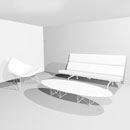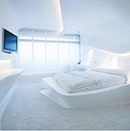
White Out
White Out describes a space in which all planar surfaces (wall, ceiling, floor), as well as furnishings and furniture are a bleached, bright white. more
White Out | Resort & Spa
application
In resort and spa environments, White Out becomes a backdrop for self-reflection, relaxation and healing.
research
The emergence of White Out as a completely white environment evokes the same effect as White Box—an “unshadowed, white, clean, artificial” space in which time and reality are suspended. Art work is exhibited without context and in isolation from anything that would detract from it.
A resort and spa environment, designated as a sanctuary for self-reflection, relaxation, and healing, pushed the parameters of White Box to another level in which all aspects of the space, including furnishings, must support a “tabla rasa” ideal. In these white settings, the interiors were meant to “recede into the background and direct the focus to the energy and activity within the space.”1 From 1980 to 2000, resort and spa designs tended toward a static white interior constructed of traditional materials such as stucco, tile, wood, and matte textiles.
As early as 1969, artists like Michael Asher began manipulating all-white spaces by adding sound and lighting effects. Asher’s installation, Untitled (White Room), enveloped patrons into a spatial transformation that seemed to “pulsate and exist without defined corners.”2 Retail designers and resort and spa designers alike have transformed White Out architecture with lighting. Natural or artificial full-spectrum lighting, juxtaposed with blue, pink, or yellow accent lighting, are used to soften the planes of the white interior, as well as offer the most flattering illumination for human skin tones. Natural and artificial sources of sunlight have also been demonstrated to reduce stress and improve mood, contributing to the concentrated experience of celebrating oneself against a backdrop of nothingness. Light sources contribute to a glowing plane effect, as opposed to point sources with piercing intensity. In his hospitality interiors throughout Turkey, Eren Talu’s “use of the color white throughout, which represents purity, acts as a kind of backdrop against which guests can add their own tone or personality to the design.”3 His washes of pink, yellow, and blue light allow the playfulness of light to add dimension to the space.
Derived from the static, traditional all-white guestroom of Philippe Starck’s Delano Hotel in Miami Beach, the addition of colored lighting, new materials and organically formed wall and ceiling planes have moved White Out to new expressions. The best of this example is Zaha Hadid’s design for Hotel Puerta America (2005) in Madrid.4 The fluid forms of the latest iteration of White Out create undulating interiors that enable guests’ minds to disassociate themselves from the ordinary.
end notes
- 1) Kimberly Bradley, ed., Design Hotels Yearbook 08 (Berlin: Design Hotels AG, 2008), 205; Anne Farrell, ed., Blurring the Boundaries: Installation Art 1969-1996 (San Diego: Museum of Contemporary Art, 1997), 82.
- 2) Bradley, ed., Design Hotels Yearbook 08, 465; Guest Room, Hillside SU [2003] Eren Talu; Antalya, Turkey in “Turkish Delight,” Interior Design 74, no. 9 (July 2003): 185- 188.
- 3) Guestroom, The Delano [1995] Philippe Starck; Miami Beach, Florida in “The Delano,” Interior Design 66, no. 12 (Oct. 1995): 94-95, 99; Herbert Ypma, Hip Hotels: City (New York: Thames & Hudson, 2001), 89.
- 4) Evidence for the archetypical use and the chronological sequence of White Out in resort and spa was developed from the following sources: 1990 Lobby, Cheju Shilla Hotel (1990) WATG; South Korea in “Mediterranean Korea,” Interiors 152, 11 (Nov. 1993): 52; Guest Room, Delano Hotel [1995] Philippe Starck; Miami Beach, FL in “It Takes a Village,” Interior Design 70, no. 1 (Jan. 1991): 201; The Hempel [1996] Anouska Hempel; London, UK in “Hotels as Hip as Thou,” Hospitality Design Magazine 21, no. 5 (July 1999): 51 / 2000 Dining Room, Madison Resort [2001] BAMO; Carmelo, Uruguay in So-Chung Shinn, “International Appeal,” Interior Design 72, no. 1 (Jan. 2001): 206; Lobby, Huntley Hotel [2003] RTK Architects and Thomas Schoos Design, Inc.; Santa Monica CA in “California Dreamin’,” Hospitality Design Magazine 28, no. 1 (Jan. 2006): 71; Lobby, Hospes Amerigo [2004] Hospes Design and Elvira Blanco; Alicante, Spain in “Divine Inspiration,” Hospitality Design Magazine 28, no. 1 (Jan. 2006): 64; Guest Room, Hotel Puerta America [2005] Jean Nouvel; Madrid, Spain in “Womb with a View,” Hospitality Design Magazine 27, no. 8 (Nov. 2005): 89-93; Pool, Bath Spa [2006] Nicholas Grimshaw + Partners; Bath, UK in “Bath/Spa,” Architectural Record 192, no. 2 (Feb. 2004): 117-21; Lounge, Lanserhof [2006] Regina Dahmen-Ingenhoven; Lans, Austria in Spa Design (Kohn: Daab, 2006), 101; Lobby, g Hotel [2006] Douglas Wallace and Philip Treacy; Galway, Ireland in “Hats Off,” Hospitality Design Magazine 29, no. 2 (March 2007): 90; Restaurant, Shangri-La Hotel [2007] CL3 Architects; Beijing, China in Andrew Yang, “Asian Fusion,” Interior Design 78, no. 8 (June 2007): 219-24; Dining Room, Mondrian [2007] Benjamin Noriega-Ortiz; Scottsdale, AZ in C.C. Sullivan, “In the Beginning . . . ,” Interior Design 78, no. 8 (June 2007): 208-09, 212.
bibliographic citations
1) The Interior Archetypes Research and Teaching Project, Cornell University, www.intypes.cornell.edu (accessed month & date, year).
2) Goldfarb, Rachel. “Theory Studies: Archetypical Practices of Contemporary Resort and Spa Design.” M.A. Thesis, Cornell University, 2008, 52-59.

